If you’ve ever written a class set of desk name plates by hand, you know the feeling. It’s time consuming, and if you’re like me, your handwriting is less than perfect (to put it nicely) and you misspell a kid’s name or two because you’re distracted by the 801 other things you need to do to get ready for the first day of school.


As you do this, you know for certain that you’ll have to rewrite or trash some of those name plates.
This used to be me when I was a classroom educator.
It was also my husband, year after year, for 17 years as a first grade teacher.
Looking back on it, the name plates we both used were pretty basic. Aside from the letters of the alphabet, they had no solid literacy support. And they definitely were not editable!
We didn’t know any better at the time. We do now, and we really wish we had editable desk name plates like the ones we make today!
When properly designed, student name tags or desk plates can serve your students far beyond just being a label for their name.
A desk name plate (preferably an editable one) has the potential to support your emerging readers in powerful ways. It can fast-track their developing phonics skills and give them the confidence to think and work independently.
In this post, I’ll walk you through 5 practical ways to use editable desk name plates to support your emerging readers, starting on day one!
1. Use Embedded Mnemonics to Strengthen Letter-Sound Connections.
Before we talk about desk name plates, let’s talk for a minute about the alphabet letters on those name plates.
You know how frustrating it can be for a child who doesn’t know which letter represents a particular sound.
This is especially common for those kids who will be in your intervention groups with little knowledge of phonemic awareness and limited exposure to print.
Here’s where we can rely on an alphabet of embedded picture mnemonics…
There is no picture of a keyword over, under, or next to a letter. The image is embedded within the shape of the letter itself.
This can more effectively help your young learners make the connection between letters and sounds. When stuck on a sound, they see a familiar keyword picture in the shape of the letter that represents it.
For instance, the lowercase b is formed with a baseball and bat…


And the lowercase s becomes a seal jumping back to catch a fish…


Here are three key reasons embedded mnemonics are so effective:
- They reduce cognitive load. Embedded mnemonics allow your students to see one integrated image instead of having to look back and forth between a letter and a keyword picture.
- They support acquisition AND retention. The embedded image serves as a memory aid, and this anchoring strengthens the connection between the sound tied to the image and the letter embedded within it.
- They are especially powerful for our at-risk readers. Struggling readers need lots of repetition and benefit a great deal from the extra support that embedded mnemonics can provide.
This is why I recommend using desk name plates in your classroom that have letters with embedded mnemonics.
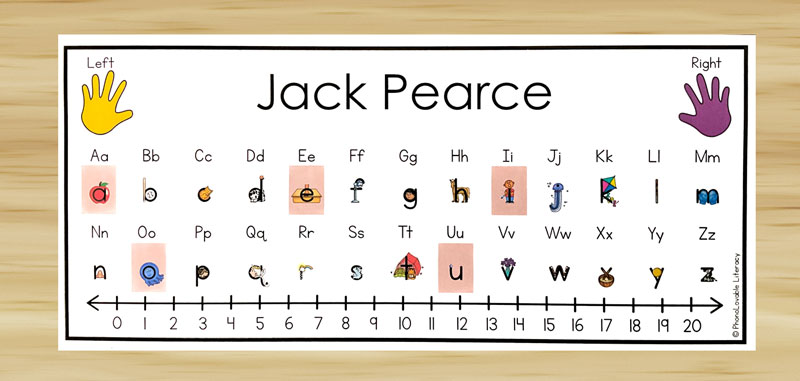

Having these embedded mnemonic cues on their desk name plates, right at their fingertips all day long, makes for more independent and confident learners!
2. Introduce Letter-Sound Correspondence from Day One.
My husband has often told me that when he taught first grade, those first few weeks always felt like a juggling act.
On one hand, he spent those first weeks introducing his new students to short vowel CVC words. But on the other hand, it was still important for those first graders to have daily review of letter sounds. Even in first grade, we’ve both had kids without much letter-sound knowledge at all.
His long-range plans required him to review one letter sound per day during the first six weeks of school. He always had students who relied on that consistent review of basic letter-sound correspondences they learned in kindergarten. That “summer slide” is no joke!
They used Circle Maps for the daily letter review. They began by having the letter of the day in the center of the circle. Then, they brainstormed words that began with that sound. As my husband recorded the words, he and his students would draw simple pictures to go next to each word.
If he used name plates with embedded mnemonics back then, his kids who struggled the most would have gotten caught up so much faster.
He would still have done the daily review, but with one major difference. A letter with an embedded mnemonic would have been in the center of the circle rather than the letter alone.
Having these completed Circle Maps displayed in the classroom AND seeing them on their desk plates would have quickly built those meaningful connections his kids desperately needed.
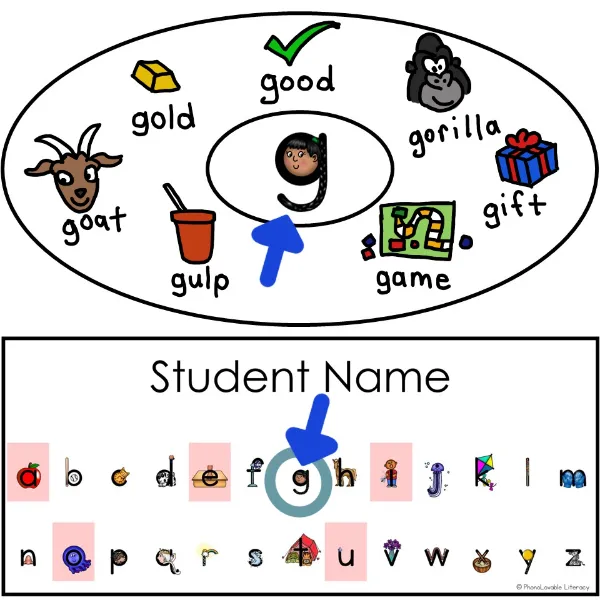

When you start the year off setting up visual tools like desk name plates with embedded mnemonics, your students are building that sound-symbol awareness from the get-go.
Instead of hunting down the sound every time they get stuck, students can simply glance down at their desk to see the letter-sound connection reinforced right in front of them.
3. Support Students As They Work Independently.
It’s small group time, and you are providing systematic, explicit literacy instruction at your table. How do you make sure your other students are given targeted opportunities for independent practice and implementation?
Here’s yet another example of how desk name plates with embedded mnemonics can come in handy. They can offer your students just the right level of visual support during independent work time.
They can give your kids a place to look before raising their hands. That kind of scaffolding can give them the stamina and confidence to keep pushing through their work. There will be no need to disrupt the important learning happening in your small group. And it might even reduce the number of “Teacher, how do you spell ________?” questions you get each day!


4. Customize Desk Name Plates for Every Student with Editable Options.
Back when I was teaching my own classroom of first graders, my students’ name plates came in one version: generic. I’d handwrite each name before the first day of school, only to discover that several students went by a nickname or middle name I hadn’t been told. So I would either rewrite it or, if I could get away with it, tape a new strip on top and try not to make it look messy.
Now as I look back, I really wish I had editable desk name plates or at least a greater selection of options. Not only would they have made for much cleaner name changes, but I would have been able to actually customize the name plate for the child sitting at that desk.
Some students need to see larger print than their peers. Others benefit from simplified visuals with less distractions. Perhaps some students could learn how to write their names faster if certain vowels or letters were color-coded. And in my intervention groups, I often want fewer elements on the desk strips so we can zero in on just the letter-sound work my students are trying to master.
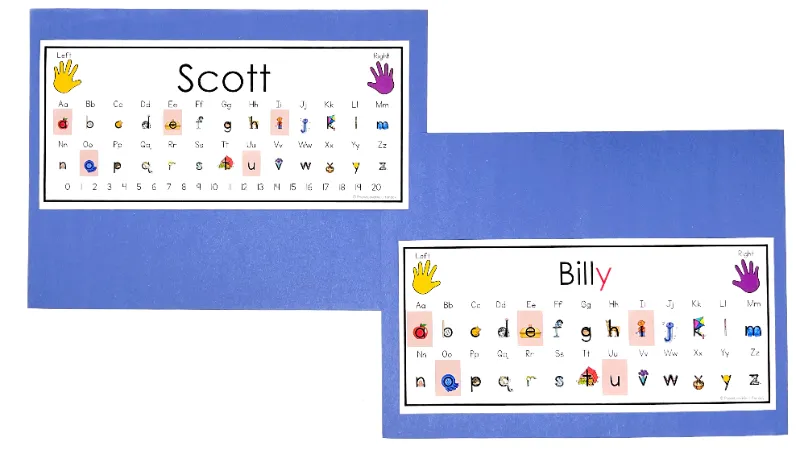

That’s what’s so wonderful about editable name plates that have a variety of options. You can meet students where they are and differentiate with minimal effort.
5. Make Your Intervention Time More Efficient.
One of the best teacher hacks my husband ever stumbled upon was attaching desk name strips to the back of little pencil baskets that were Velcro’ed to each student’s desk. It seemed simple enough, but it solved two problems at once: name visibility and portability.
During intervention, he would call over a small group of students, and they’d bring their baskets. This allowed each student in the group to have some additional letter sound support at the table with them. It was a simple routine to implement that made a difference, especially for his kids receiving Tier 2 intervention or special education services.
If you’re using desk name plates, you can do something similar, whether you have Velcro baskets or not. If your kids do not use portable baskets, just keep an extra set of the same name plates your students have at their desks within reach at your reading table. Your students who need the most support with letter sounds will benefit from having the same consistent tool at their desks and during small group work.
The name plates you choose for your classroom can have potential. They can be so much more than just a label with a child’s name on it.
Why PhonoLovable Name Plates Save Time and Frustration
Back-to-school prep is already overwhelming. Why not remove one task from your long beginning-of-the-year to-do list? That’s one reason why my husband and I created our editable desk name plates in the first place.
We designed our desk name plates so that you can type directly into the editable versions. You can adjust the font size to fit your students’ needs and choose from a variety of layout options.
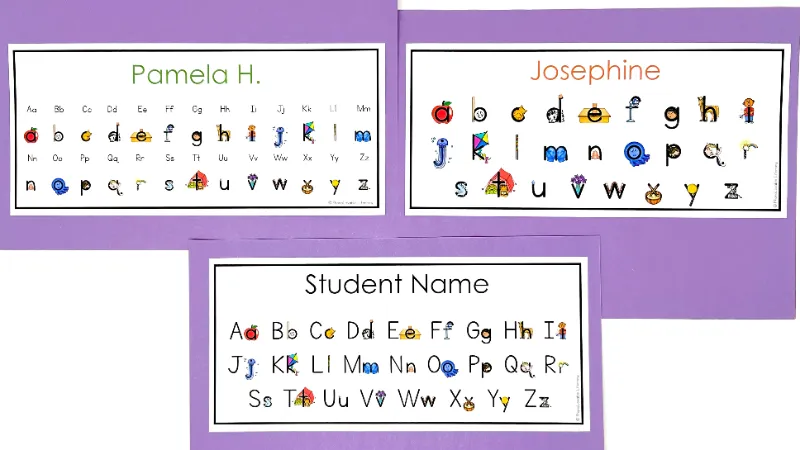

Whether you want a full alphabet strip with embedded mnemonics or just a simpler name tag, you’ve got choices!
We also threw in some extra printable alphabet strips (non-editable) that feature the same embedded mnemonics, just for some additional options. You don’t have to buy five separate resources. You just print the versions that make the most sense for your kids.
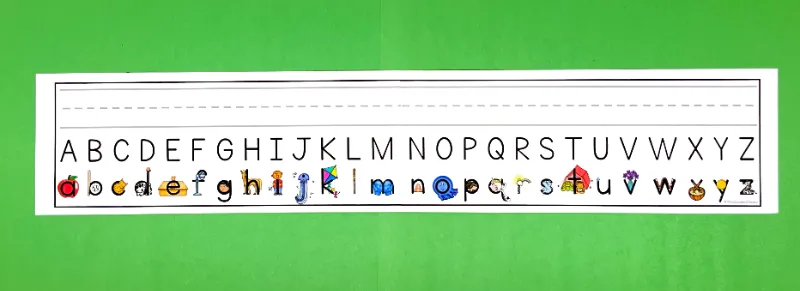

Each name plate and desk strip is in color, but you can print them in black-and-white if that’s what your setup allows.
Our goal is simple. We want to help your students and make your life easier. When you don’t have to waste your precious time messing with formatting or rewriting names, you can get back to doing the more important things in your classroom that matter the most for your students.
Want to Try These Editable Desk Name Plates in Your Classroom?
I hope this post gave you some fresh ideas for using editable desk name plates in ways that truly support your students.
If you’d like to try them out for yourself, you can click on the cover below to preview all the different versions included. See which layout best fits your classroom.
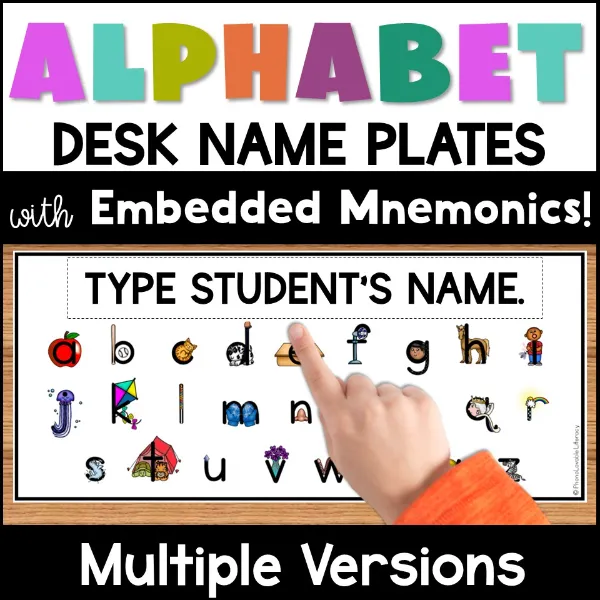

Let these desk name plates set the tone for what may be a smooth and wonderful start to your school year. We will be cheering for you and all of your students!

